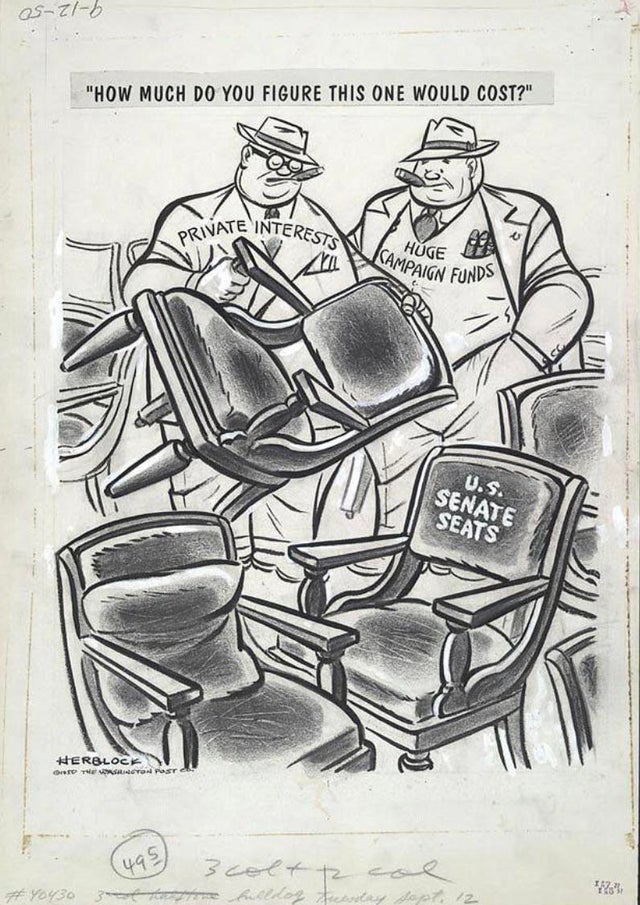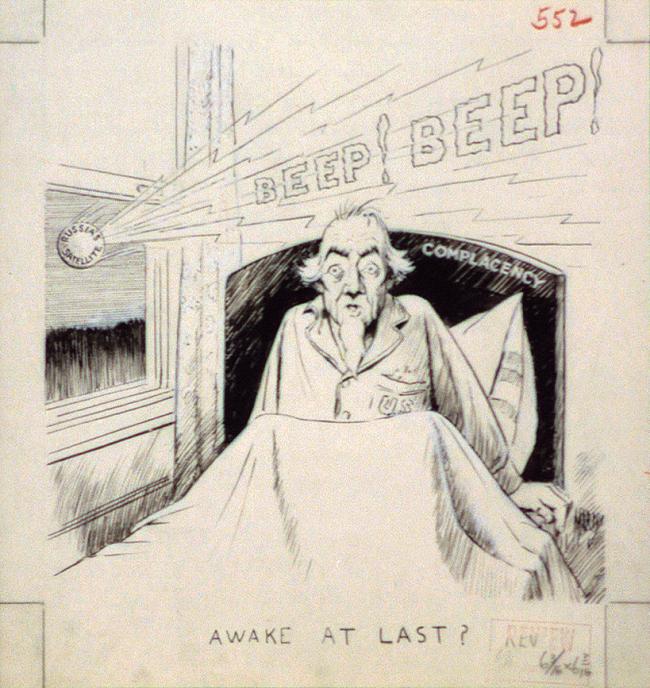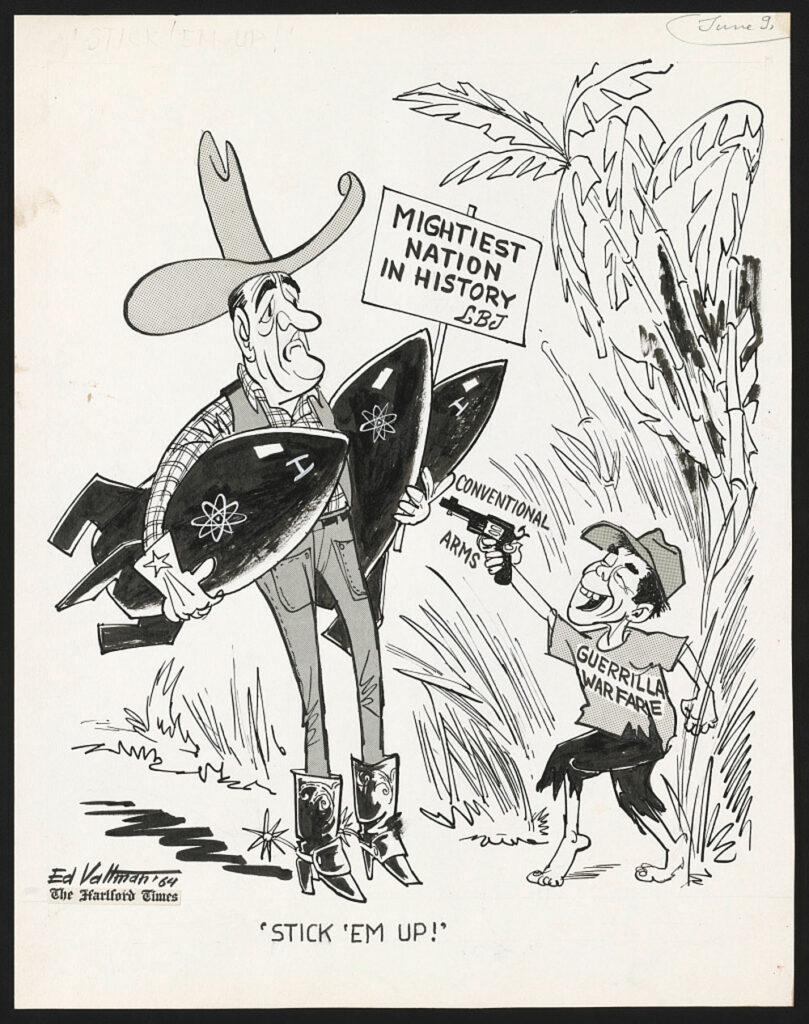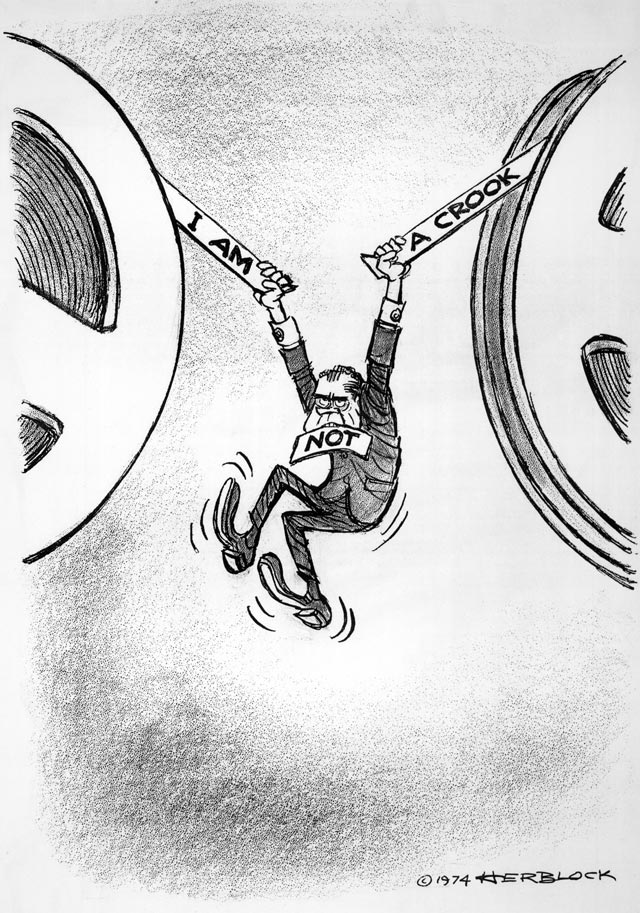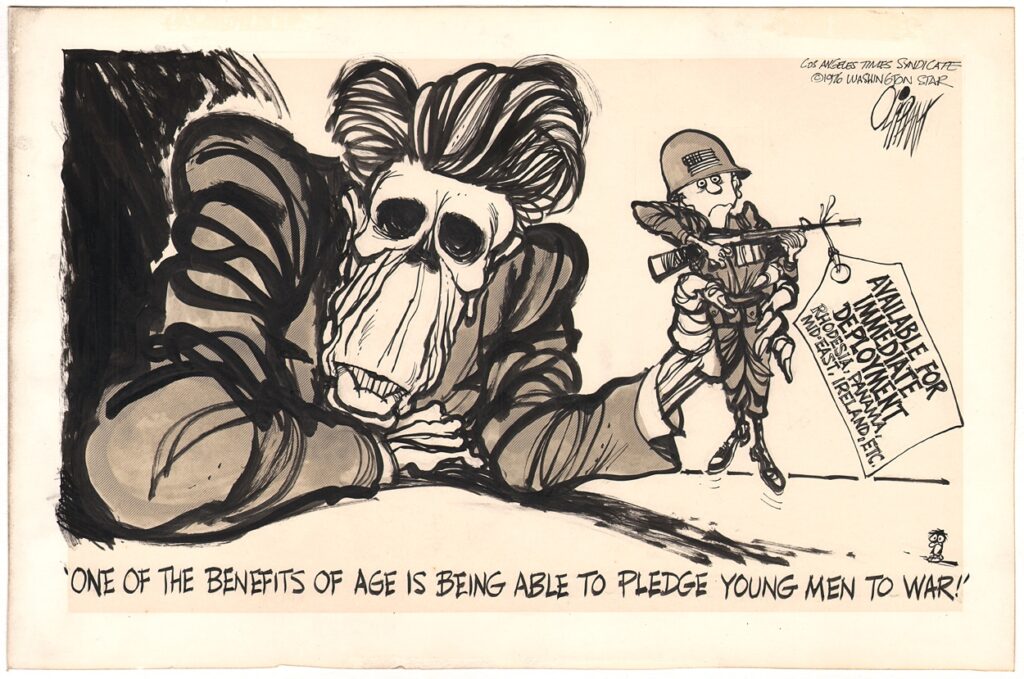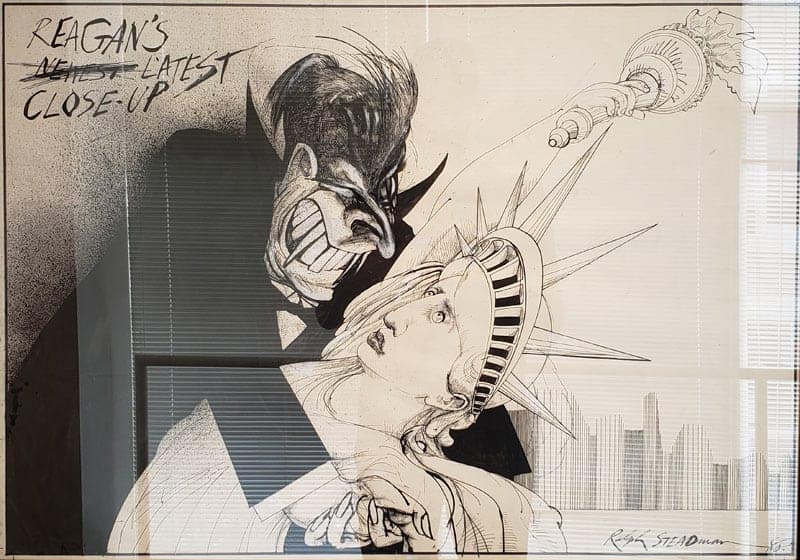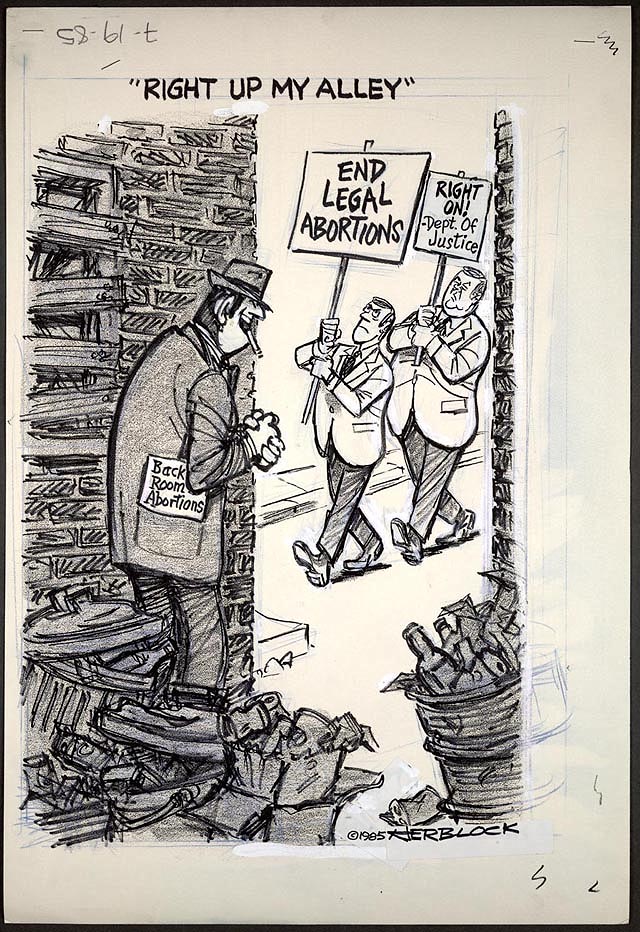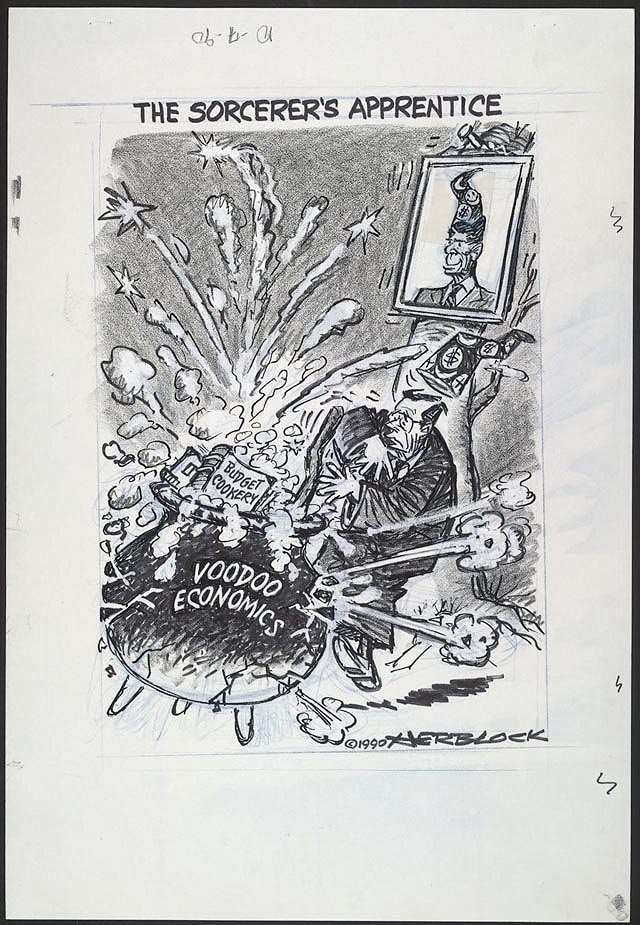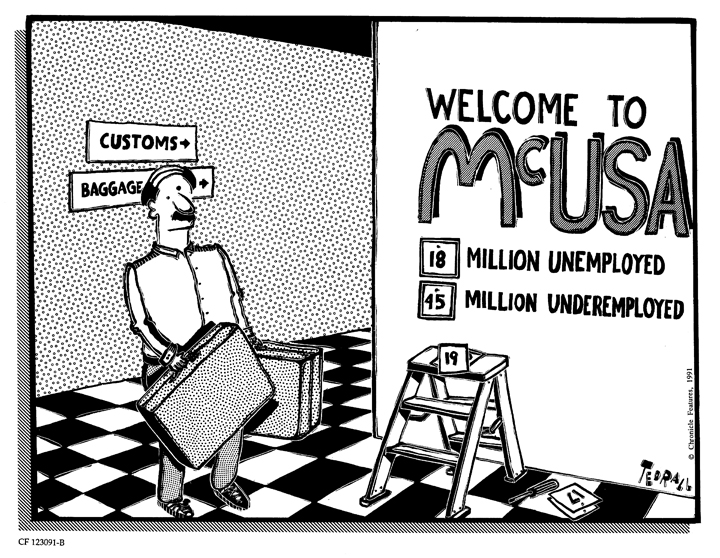During this era, modern art movements began influencing political cartoons leading to an evolution in style.
Political cartoons during this time period continued to be published mostly in newspapers with many national and local periodicals featuring a section for political cartoons.
During this period, newspaper advertisers and publishers began exerting more of an influence over political cartoons, even forcing papers to drop controversial cartoons from their pages (see David Levine’s Screwing the World, not featured here due to its adult content). Famous cartoonists such as Herb Block and Ted Rall helped shape the art form during this time period.
Click on each image to enlarge.
How Much Do You Figure This One Would Cost?
Herb Block, 1950, published in the Washington Post, Washington D.C.
In this cartoon, two men representing “private interests” and “campaign funds”, are looking at Senate seats wondering how much they could be bought for. Herb Block was one of the most prolific political cartoonists of the twentieth century. During the course of a career stretching nine decades, he won three Pulitzer Prizes for editorial cartooning.
Cartoon shared with permission from Herb Block Foundation.
Awake At Last?
Edwin Marcus, 1957, for the New York Times, New York, New York
Panic struck the United States when the Soviet Union launched the first satellite, Sputnik, in 1957. Sputnik was a wake-up call for Americans on how far behind they were in the realm of space exploration. Sputnik began the “space race” which culminated in the Apollo 11 moon landings of 1969. In this cartoon, Uncle Sam is rudely awoken by Sputnik careening across the sky outside his window.
Stick ‘Em Up!
Ed Valtman, 1964, for the Hartford Times, Hartford, Connecticut
A caricature of a Viet Cong guerilla fighter points a pistol at a caricature of American president Lyndon B. Johnson, who holds nuclear missiles under his arms. This cartoon comments on the Viet Cong’s military success against the “mightiest nation in history.” Ed Valtman was an Estonian-American cartoonist who fled Estonia after the USSR occupied it in 1944 and came to the United States. In 1962, he won the Pulitzer Prize for Editorial Cartooning.
Miraculous — He Can Walk On Mud
Herb Block, 1972, published in the Washington Post, Washington, D.C.
The Republican party stood by their candidate Richard Nixon throughout the Watergate Scandal. This cartoon shows hands, representing the GOP, creating a path for him to walk on through the muck of “scandal.”
Cartoon shared with permission from Herb Block Foundation.
I am Not a Crook
Herb Block, 1974, for the Washington Post, Washington, D.C.
This cartoon shows Richard Nixon dangling from an audio reel and eating his words. The White House audio files ultimately proved that Nixon did engage in criminal behavior during the Watergate Scandal.
Cartoon shared with permission from Herb Block Foundation.
One of the Benefits of Age is Being Able to Pledge Young Men to War
Pat Oliphant, 1976, for the Los Angeles Times, Los Angeles, California
Ronald Reagan and Gerald Ford squared off during the Republican Party primary for the 1976 presidential election. During the primary, Reagan made comments about being more forceful in deploying US troops to such places as Rhodesia, Panama, Ireland, and more. Ford supporters attacked Reagan for this statement including in this political cartoon which depicts a skeletal caricature of Reagan selling off young American soldiers. Pat Oliphant is an Australian-American cartoonist who immigrated to the United States during the 1950s. He is particularly known for his caricatures of American presidents and other global leaders.
Reagan’s Latest Close-Up
Ralph Steadman, 1980
Ralph Steadman is a British illustrator best known for his collaboration with Gonzo journalist Hunter S. Thompson. Steadman also created numerous political cartoons and picture books. In this cartoon, a Dracula-like Ronald Reagan prepares to suck the blood out of Lady Liberty.
Stop ERA
Kate Salley Palmer, 1982, for the Greenville News, Greenville, South Carolina
The Equal Rights Amendment (ERA) was a proposed amendment to the Constitution designed to guarantee equal legal rights for all citizens regardless of sex. It sought to end any legal distinctions between men and women. The amendment seemed destined for ratification during the late 1970s until right-wing Christian activist Phyllis Schlafly rallied conservative women to oppose it. One of the women allied with Schlafly, and therefore opposed to the ERA, was South Carolina politician Norma C. Russel who is lampooned in this cartoon.
Courtesy of University of South Carolina, South Carolina Political Collections via South Carolina Digital Library
Right Up My Alley
Herb Block, 1985, published in the Washington Post, Washington, D.C.
This political cartoon suggests that illegal and unsanitary abortions would increase if abortion was made illegal in the US. Two men march with signs demanding an end to legal abortions while a nefarious character entitled “back room abortions” schemes from an alley.
Cartoon shared with permission from Herb Block Foundation.
The Sorcerer’s Apprentice
Herb Block, 1990, published by the Washington Post, Washington, D.C.
In 1980, while competing against each other for the Republican party nomination for presidential candidate, George H.W. Bush criticized Ronald Reagan’s economic plan as “voodoo economics.” However, during the 1990 presidential election, Bush advocated a continuation of Reagan’s economic agenda which included what he had once labeled “voodoo economics.” In this cartoon, Bush is depicted as Reagan’s “sorcerer’s apprentice” with a cauldron of “voodoo economics” blowing up in his face.
Cartoon shared with permission from Herb Block Foundation.
Welcome to McUSA
Ted Rall, 1992, for the San Francisco Chronicle, San Francisco, California
Ted Rall is one of the most prolific cartoonists in American history. At his peak in popularity during the 1990s, Rall’s cartoons were appearing in over 100 newspapers around the USA. Rall’s 1990s work focused on the issues and concerns surrounding young members of Generation X. In this cartoon, a new immigrant comes to “McUSA,” a satire on the corporatization of American culture, only to find millions unemployed and millions more “underemployed.”
Cartoon shared with permission from Ted Rall.


